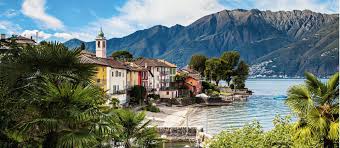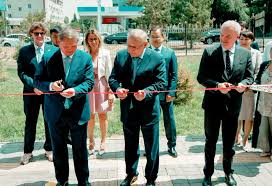Relishing Italy’s River Ticino

Milan: Let me take you down my home river, the Ticino. The Italian Ticino, that is, just 30 minutes from Milan by car or train.
It’s a supremely protean creature, rising in the Swiss Alps, plunging and rushing its rocky way (much-loved by kayakers) down to Lake Maggiore, where it sneaks into Italy under cover of the lake to reappear in altogether more placid form at the picturesque town of Sesto Calende. That’s where we’re going to start our trip. Ahead of us are about 60 glorious miles south to Pavia, where the Ticino surrenders its glacial waters to the more majestic Po, Venice-bound.
So why all the enthusiasm? For about 30 miles, despite its proximity to half a dozen ancient towns, this river has been left absolutely to its own meandering devices. Declared a parco naturale in 1974, it wanders here and there, shifting its course every season, over white shale banks through woods of elm and willow, tangles of honeysuckle and hawthorn, nettles and bulrushes, blackberries and wild strawberries. If you crave the utterly and amiably natural, this is paradise.
Not at first. Walking south from Sesto Calende, the river is no more than ordinarily adorable, a wide expanse of transparent water between wooded slopes, neatly embanked to allow picturesque villas to prick your envy and waterside restaurants to offer generous fry-ups of pesciolini e rane, little fish and frogs.
Ticino river at the dam of Panperduto in Ticino Park, Somma Lombardo, province of Varese, ItalyGW3N4E Ticino river at the dam of Panperduto in Ticino Park, Somma Lombardo, province of Varese, Italy
The water is being made to behave by a dam. It appears at Panperduto (lost bread), six miles south of Sesto Calende, a place where barges heading down from Lake Maggiore to Milan once risked tipping in rapids and losing their loads. Here an elegant 19th-century structure of 20 and more narrow arches stretches out across the river, its sluices channelling off water into the first of many canals for transportation and irrigation. Visitors can explore a museum to see how it all works, lounge on the deckchairs provided, or even spend a night in the attached B&B (doubles from €80). Meanwhile, having surrendered some volume to human enterprise, the rest of the river is now free to wander where it will, eroding here, silting up there, forgetting itself in shady backwaters, tipping and murmuring this way and that round pebble banks or thick mounds of reeds and flowering robinia.
When the water swells with the spring snowmelt it uproots whole trees and carries them off. Many end up trapped mid-river, forlorn branches swaying in the stream, perfect perching places for herons and cormorants. The air is alive with birds of every kind. Swans, ducks and moorhens brood on their nests. Kestrels circle above. Elegant egrets prod the shallows with their sharp beaks. Kingfishers flit and woodpeckers make themselves heard in the trees. Standing still in the dense undergrowth at the waterside, you’ll be hard put to distinguish all the different chirrups and trills, cooing and warbles. Not to mention the steady insect hum that pulses in the summer air.
But how to savour all this, to really be there in the midst of it? The simplest solution is walking. The E1, the European long-distance path that starts at the icy tip of Norway and stretches all the way to Sicily, runs as near to the Ticino as it can and doubles up as a cycle path. Local websites (parcoticino.eguide.it and ente.parcoticino.it) suggest excursions and have maps. OK, they sometimes refer to tracks the river may have swallowed up a decade ago, but take it as a challenge! We’re talking ambling and curiosity here, not forced marches. Follow a quiet track to its end and often enough you’ll find some humble no-profit development where locals are enjoying a glass of wine under battered sunshades, perhaps bathing or fishing or simply soaking up the busy hush of it all.
The towns along the way – Magenta, Vigevano and, above all, Pavia – are all gems. Tiny villages boast church facades with the cheerful emblem of the Visconti family: a snake swallowing a baby. At Tornavento the Naviglio Grande (Grand Canal) leaves the river’s left bank and sets off for Milan; completed in the 13th century, it is Europe’s oldest functioning long-distance canal. So that’s another walk or cycle ride to consider, taking in the ancient centres of Robecco sul Naviglio and Abbiategrasso.
But my favourite stretch of the Ticino is the 14 miles between Vigevano and Ponte delle Chiatte near Bereguardo. And my favourite method of transport is the canoe. You don’t have to be an experienced paddler; there are no rapids here. The river is broad and shallow, gliding gently over bright pebbles. Countless pools, islands and water-lillied backwaters offer themselves to your curiosity. There are no buildings visible, no roads, no bridges. From time to time you may come across a family barbecuing on the shore, children swimming, a nudist with a dog, a small motorboat chugging up from Pavia. Otherwise, nothing but water, woods and birds, until, at Ponte delle Chiatte (a tiny road rumbling across a dozen moored barges) there’s the surprise of an open-air swimming pool on the right bank and the friendly Bar del Ponte on the left.
Despite a few moments when the insects become a bit annoying, it’s really hard to imagine a better day out.





